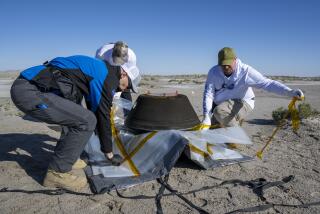Scientists Begin Receiving Data From Jupiter : Space: Experts download digital information sent from probe to Galileo spacecraft and hope to have some preliminary results soon.
- Share via
Engineers at the Jet Propulsion Laboratory in Pasadena were all ears Saturday as the Galileo spacecraft began to send back news of its encounter with Jupiter almost a full day earlier than planned.
“Things were going so well we decided to go ahead and start downloading,” said Galileo systems manager Jim Marr.
The news from the probe--now vaporized in the giant planet’s high-pressure atmosphere--is coming down to Earth as so much computer babble. But at least it’s talking, and its vocal cords appear to be in good shape.
“I never knew ones and zeros could be so exciting,” said probe project manager Marcie Smith, referring to the digital code that carries the information on radio waves through space.
The data coming into JPL traveled via radio signal from the Jupiter probe into the mother ship’s main computer Thursday. From there, it hitched a ride on a continuous radio broadcast to NASA’s deep space antenna network, and finally to JPL.
The engineers don’t know what the strings of numbers mean yet. Decoding the digital bits was to begin this morning, when the data gets parceled out to scientists responsible for various experiments.
“We certainly hope it isn’t gibberish,” said Marr, eating a probe-shaped cookie designed and baked by flight operations manager Charlie Sobeck. “I hope Jupiter had as much fun eating our probe!” Marr joked.
Smith and Sobeck had been looking at ones and zeros all morning, ever since the command was sent to Galileo to start regurgitating the data transmitted by the probe before it turned to Jupiter dust.
Somewhere in those strings of numbers lie detailed descriptions of a scene never glimpsed before by humankind: the inner world of a giant gas planet.
The miniature science lab that parachuted through Jupiter’s ammonia ice crystal sky Thursday carried six sophisticated instruments designed to measure everything from the amount of heat rising from the planet’s liquid interior to the types of particles floating in its atmosphere, to lightning and storms.
Each of the six instruments has its own science team --and only they can translate the numbers into properties such as temperature, pressure, wind speed and chemical composition.
Some of the teams are expected to announce some extremely preliminary findings as early as Monday.
But without engineers fluent in digital babble, the scientists would have nothing to analyze.
Galileo’s star-crossed mission to Jupiter became even more dependent on the data managers when its main antenna failed to unfurl in 1991. For a time, scientists feared that all was lost. But then Marr and his team were called in to figure out how to turn the tiny low-gain antenna into the spacecraft’s new mouthpiece--a task akin to turning Cinderella’s rags into a ball gown.
Each measurement from a probe instrument--for example, a temperature reading--carried not only the relevant numbers, but also extra information telling the engineers just how reliable each bit of information should be.
In addition, each string carried a header, like a chapter title. Without the main antenna, however, the stream of bits from the spacecraft has slowed to a trickle. In the interests of getting the data back as quickly as possible, both the headers and the “reliability” numbers were eliminated.
So the data coming into JPL today is about as raw as it gets. It will be sent three times, to minimize confusion between real signals and background noise. The data also arrives in a confused jumble--with the bits from, say, the cloud particle detector mixed up with the bits from the lightning or temperature detectors.
All this gets sorted out at JPL before the data is sent to the science teams.
Altogether, the data takes several hours to get to the scientists, including the 52-minute light-speed trip from Jupiter. “Then, [the scientists] start . . . arguing about what it means,” Sobeck said.
Science teams not located near JPL will be able to pluck their data off the Internet. On Saturday, Smith and Sobeck remained enthralled with the strings of letters and numbers coming up on their screen.
Unlike the decimal system, based on the 10 fingers of human beings, the computers count with 16 digits.
Smith said they were waiting to see exactly such a string of numbers Thursday when word came through telling the Galileo team that the probe made it safely through Jupiter’s clouds.
They were worried that in all the excitement they might read the wrong string. “We’d see a 58, but it would be the wrong 58.” But the space information highway from Galileo seems to be clear of obstacles, at least for now. Marr said they know that the computer is doing what it should be doing. “It’s telling us, ‘I just got 80 bits out of this location.’ We know it’s getting data from the right place,” he said. Whatever marvelous sights and sounds might be buried in that data, however, will have to wait.
“We’ll find out tomorrow,” Sobeck said.
By Wednesday, engineers hope to have the first 40 minutes of data. Then Jupiter--with Galileo caught in its gravitational grasp--will slip behind the sun, and the trickle of data will stop for several weeks. Next spring, Galileo will send back all of the data--including reliability estimates and headers--so scientists will have a chance to check their results.
More to Read
Sign up for Essential California
The most important California stories and recommendations in your inbox every morning.
You may occasionally receive promotional content from the Los Angeles Times.













